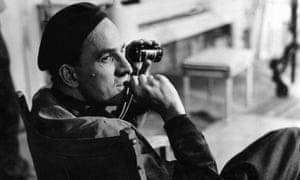The Guardian – Ingmar Bergman’s spellbinding films made his female stars immortal. But they weren’t all grateful. Could this famously manipulative genius have survived in the #MeToo era?
In 1971, Ingmar Bergman had just completed his first English-language film, The Touch. It starred Elliott Gould as an American archaeologist in Sweden, who has an affair with a beautiful, troubled woman, played by Bergman regular Bibi Andersson. To promote it, Bergman and Andersson made an extraordinary appearance on America’s Dick Cavett Show – an unimaginably rare TV outing for this director, rather like seeing Jean-Luc Godard pop up on Trevor Noah’s The Daily Show.
Seated next to his very quiet star, Bergman declared: “I think acting is a very special women’s profession. Women have much more talent for acting. I think women, perhaps from education, are more used to enjoying looking into the mirror that is the audience or the camera’s eye. If a man stands in front of a mirror, he can perhaps feel a little bit ashamed. He looks at his clothes, his hair and his face. A woman by education is not ashamed of looking at herself.”
Could Bergman really have been so naive as to think that was true? Did he really imagine that a wince of dissatisfaction at one’s own reflection was restricted to balding, ageing males, and that women were all as beautiful as the goddesses of his own movie universe? Or was he using women and female characters to exalt his own narcissism and male anxiety?

In 1983, he made a short film, Karin’s Face, all about family photographs of his mother Karin (it was a name he continually favoured for characters). A Freudian interpretation of Bergman’s women is tempting, if glib – although the director is himself virtually a parallel Freud, presiding over his own modern mythology of sexual dysfunction and family tragedy.
Bergman – the great poetic master of doubt, faith, love, erotic enchantment and the silence of God – was born 100 years ago this year. Although he had the seriousness and poise of Ibsen or Strindberg, in his younger days he was capable of great comedy and gaiety. His centenary is being celebrated with a complete retrospective at London’s BFI. Among many other things, this is a chance to look anew at the generation of female stars who found immortality through his movies.
These women also found themselves submitting to an intense and intimate working relationship, which sometimes became a sexual one. Bergman was married five times and a great deal of his income was earmarked for child support. Many female stars found him intrusive and oppressive: he might conceivably today find himself liable to a #MeToo complaint. There is something uneasy about the fact that Harriet Andersson began her relationship with Bergman after going to his office to discuss her career over tea.

No one did more to popularise Bergman for English-speaking audiences than Woody Allen. Like his Swedish idol, Allen adored and fetishised women, returning to the same faces like Monet to his lilies. Bergman, though, did not share Allen’s obsessive interest in younger women. It is worth pointing out that the Swede’s 1978 film Autumn Sonata – starring Ingrid Bergman and Liv Ullmann as a mother and daughter – is about a stepfather abusing a young teen stepdaughter and being specifically identified as morally culpable.
There was almost a Bergman “type”, and it is no accident that such stars were often cast as sisters or even mirror-images of each other. The Bergman female star would be lit, framed, styled and cast in a distinctive way – an open-faced, often blonde woman whose beauty was complicated by a pained or martyred aspect.
Ullmann and Bibi Andersson each portrayed the ultimate tragisexual Bergman heroine in his compulsively watchable Persona of 1966. Ullmann is a stage actor who retreats into silence after a nervous breakdown, Andersson a nurse tasked with coaxing her into speech at a summer lake house. They do look strikingly similar and their relationship becomes intensely and erotically intimate, but also alien and mysterious, like trying to embrace your reflection in the mirror – the mirror Bergman claimed female performers found more congenial.
In 1972’s agonised Cries and Whispers, Ullmann, Harriet Andersson and Ingrid Thulin play Agnes, Maria and Karin, three sisters in the early 20th century. Agnes is dying of cancer and her two sisters have come back to the family home, ostensibly to care for her, but are in fact in full retreat from the breakdown of their marriages, secretly convulsed with self-hate, guilt and despair.
They resent the maid Anna, played by Kari Sylwan, who has an intense bond with Agnes and climbs into bed with her for a very sensual pietà, the servant cradling her mistress’s dying body, bringing pain and sexual desire into a shocking interrelationship. When the character played by Thulin, who had starred in Bergman’s masterly Wild Strawberries, mutilates herself with broken glass, the sceptical observer may see a contrived or even self-parodic flourish. But Bergman’s unflinching seriousness carries it off: a premonition of Isabelle Huppert’s ordeal in Michael Haneke’s The Piano Teacher.

The movie is similar to 1963’s hypnotic and nightmarish The Silence, in which two sisters travel through a fictional European country, living through the trauma of a Hungarian-type uprising with tanks on the street. Anna (Gunnel Lindblom) is the younger sister, a single mother with a little boy in tow. Bergman’s first closeup shot of her face on the train is a shocking masterpiece: she looks inert, blank, as immobile as a corpse, but is in fact stupefied with boredom and resentment of her bossy intellectual sister.
Ester (Thulin again) is part disapproving, part fascinated by Anna’s casual sexual adventures. She masturbates in bed. But her moans of pleasure are weirdly similar to moans of pain, because Ester is very ill. Her cries have the same desolate quality as Agnes’s in Cries and Whispers – Bergman has the same need to amplify and complicate the proclamation of sex. Perhaps this minister’s son felt he could only portray the act in the context of punitive suffering.

Bergman is renowned for those colossal closeups of women’s faces, and his greatest were on the overpoweringly charismatic Harriet Andersson, his former lover. In his 1953 film Summer With Monika – a movie that had something of the French new wave and the British kitchen sink about it – Andersson is Monika, the carefree girl who has to shrug off sexual abuse at work and who falls in love with Harry, an earnest young man who takes her for a summer of love on his motor launch and gets her pregnant. They then enter a brief and squalidly unhappy marriage.
The film was much talked about for the daring shots of Andersson swimming naked. Yet now it is most remarkable for a single closeup of her face, as she is about to cheat on her husband with a man who has given her a light in a bar. Her face fills the screen and her gaze is directed straight into the lens. Is she defiant? Contemptuous? The whole film could have been contrived for that single staggeringly powerful image. Coercive and condescending Bergman may have been to his female stars, but no one else could have given Andersson a moment as glorious as that.
One very atypical Bergman star was the superbly elegant, worldly and witty Eva Dahlbeck, who was probably just too genial to be yet another of his sexy but desolate enigmas. She is perhaps most entertaining in 1954’s uproarious romantic comedy (yes, he did once make them) A Lesson in Love. It is basically Bergman’s Philadelphia Story, a comedy of remarriage with Dahlbeck in a role that might be played by Katherine Hepburn, with the Cary Grant part taken by the very young, noticeably relaxed Bergman team player Gunnar Björnstrand. (There is also a Bergman male: upright, uptight, sometimes mutton-chopped and often gaunt and disapproving, a role frequently taken by Björnstrand, Erland Josephson or Max von Sydow.)

Maybe Bergman’s rapture was a dimension of his religious doubt: if he couldn’t believe in God, or indeed that unsatisfactory reflection of himself in the mirror, then he could turn to those passionately curated images of female beauty about whose transcendence there could be no debate. This was a kind of religious truth, but one that caused its own kind of anguish.
Was he, perhaps, inspired by Strindberg’s A Dream Play, featuring Agnes, the daughter of a god who descends to Earth to investigate humanity, to sympathise and bear witness to human pain? Bergman did once produce the drama and the playwright is mentioned in Fanny and Alexander, Bergman’s semi-autobiographical movie from 1982. In its final moments, a young actress asks her mother-in-law, a retired actress, to take part in a production of this play. She laughs and shrugs off the idea of acting in Strindberg, saying: “That nasty misogynist!”
Bergman wasn’t a misogynist. But I think, to the very end of his days, women were a mystery to him, and this gave rise to a passionate kind of worship and even creative ownership. Whatever the truth, one thing is undeniable: he created some of the greatest roles for women in cinema history.

